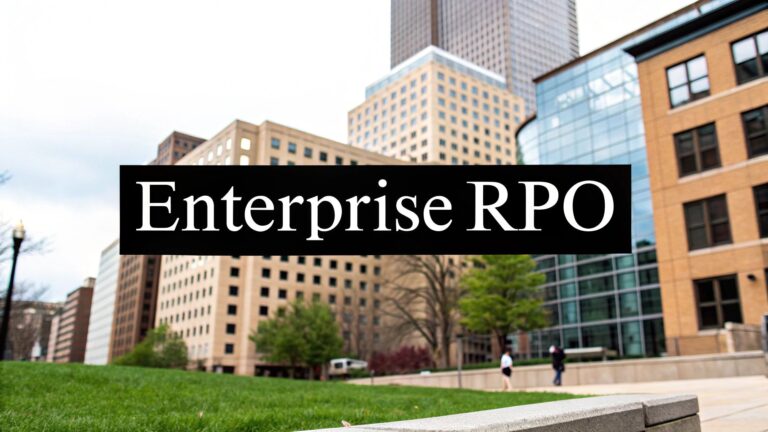Level Up Your Hiring: Diversity Strategies That Work
Want to build a truly diverse and inclusive team? This listicle presents eight practical diversity hiring strategies that deliver results. Learn how to attract and retain top talent from all backgrounds using techniques like blind résumé review, structured interviewing, and diversity-focused sourcing channels. These strategies will help you build a representative workforce. We’ll also cover setting diversity goals, crafting inclusive job descriptions, leveraging employee referrals, and partnering with relevant training programs. Implementing these diversity hiring strategies is crucial for fostering innovation, improving company culture, and accessing a wider talent pool.
1. Blind Résumé Review
Blind résumé review is a powerful diversity hiring strategy that aims to mitigate unconscious bias in the initial screening stages of recruitment. This method involves removing identifying information from candidates’ applications – such as names, addresses, graduation years, and photos – allowing hiring managers to focus solely on qualifications, skills, and experience. By anonymizing applications, the impact of implicit biases related to gender, ethnicity, age, or socioeconomic background is significantly reduced, promoting a fairer evaluation process. This strategy acknowledges that even well-intentioned individuals can be influenced by unconscious biases, and seeks to create a level playing field for all applicants.

Blind résumé review deserves its place on this list because it directly addresses a core obstacle to diversity hiring: unconscious bias in the initial screening. Features of implementing blind review often include the use of software tools that automatically redact specific information, the development of standardized evaluation rubrics focused on skills and experience, and the delayed disclosure of demographic information until later interview stages. The benefits are clear: a more diverse candidate shortlist based on merit, increased focus on relevant qualifications, and a demonstrable commitment to equitable hiring practices.
Several organizations have successfully implemented blind résumé review with impressive results. Orchestras that implemented blind auditions behind screens saw a dramatic increase in female musicians by 25-46%. Similarly, platforms like GapJumpers have helped companies increase the diversity of technical hires by over 40%. HSBC and Deloitte UK have also reported increased diversity in various roles after implementing blind CV reviews and name-blind recruitment, respectively. These examples demonstrate the tangible impact blind résumé review can have on building a more diverse workforce.
When and Why to Use This Approach:
Blind résumé review is particularly valuable when hiring for roles that typically attract a homogenous applicant pool, or when aiming to increase representation from underrepresented groups. As a CHRO, you can leverage this strategy to ensure a more equitable and objective assessment of candidates, particularly in high-volume recruitment scenarios. It’s a proactive step towards building a more inclusive organization and fostering a culture where talent is recognized irrespective of background.
Pros:
- Reduces the impact of unconscious bias in initial screening.
- Increases focus on relevant qualifications.
- Improves diversity in candidate shortlists.
- Can be implemented with relatively low costs.
Cons:
- Only addresses bias in early screening stages.
- May remove context that explains gaps in employment or unique career paths.
- Doesn’t address bias in interview stages.
- Can be difficult to fully implement in small organizations with limited resources.
Actionable Tips for Implementation:
- Use specialized software: Consider adopting tools like Applied, Blendoor, or GapJumpers to streamline the redaction process.
- Establish clear evaluation criteria: Define specific skills and experience requirements before reviewing résumés to ensure objectivity.
- Train hiring managers: Educate your team on the purpose and process of blind review to maximize its effectiveness.
- Review results periodically: Track diversity metrics to assess the impact of blind review and make adjustments as needed.
By implementing blind résumé review as part of a broader diversity hiring strategy, organizations in the IN region can create a fairer and more inclusive hiring process, leading to a more diverse and representative workforce. This approach reflects a commitment to recognizing talent based on merit and fostering an environment where everyone has an equal opportunity to succeed.
2. Structured Interviewing
Structured interviewing is a critical diversity hiring strategy that systematically reduces bias and promotes fairer assessment of candidates. Unlike traditional, unstructured interviews, which often rely on gut feelings and can perpetuate unconscious biases, structured interviewing uses a standardized approach. This means all candidates are asked the same predetermined questions in the same order, and their responses are evaluated against a pre-defined set of criteria. This methodology ensures consistency and focuses the evaluation on job-relevant competencies, creating a level playing field for candidates from diverse backgrounds.

This approach involves several key features: predetermined questions asked consistently to all candidates, standardized evaluation rubrics with clear scoring criteria, the use of multiple interviewers (ideally a diverse panel) using the same framework, and questions specifically designed to assess crucial job competencies. The questions often focus on behavioral and situational scenarios that predict on-the-job performance, allowing you to assess how candidates would handle real-world challenges.
Why Structured Interviewing Deserves its Place in Your Diversity Hiring Toolkit
Structured interviewing directly addresses a major obstacle to diversity hiring: unconscious bias. By standardizing the process, it mitigates the influence of factors like affinity bias (the tendency to favor candidates who remind us of ourselves) and confirmation bias (seeking information that confirms pre-existing beliefs). This leads to more objective, merit-based hiring decisions, ultimately improving the diversity of your workforce.
Pros and Cons for the CHRO to Consider:
Pros:
- Reduces Interviewer Bias: Standardizing the process significantly minimizes unconscious biases, leading to fairer assessments.
- Improves Prediction of Job Performance: Focusing on competency-based questions directly linked to job requirements improves the likelihood of selecting candidates who will excel in the role.
- Creates Defensible Hiring Decisions: Clear documentation of the process and scoring rationale creates a more transparent and legally defensible hiring process.
- Facilitates Fair Comparison Between Diverse Candidates: Provides a consistent benchmark for evaluating candidates regardless of background.
- Mitigates Affinity Bias: Reduces the tendency to unconsciously favor candidates who share similar characteristics with the interviewer.
Cons:
- Can Feel Rigid or Impersonal to Candidates: The structured nature can sometimes make the interview experience feel less conversational.
- Requires Significant Upfront Preparation Time: Developing robust questions, scoring rubrics, and training interviewers requires initial investment.
- May Limit Exploration of Unique Candidate Attributes: While focused, the structure may not allow for spontaneous exploration of unique skills or experiences.
- Needs Regular Updating: As job requirements change, the interview structure and questions must be revised to remain relevant.
Examples of Successful Implementation:
Global companies like Google and Unilever, as well as government agencies, have effectively implemented structured interviews to improve diversity hiring outcomes. Google’s structured interview process, informed by their data-driven People Analytics team, has demonstrably contributed to increased diversity and retention. Unilever’s adoption of digital structured interviews led to a 16% increase in workforce diversity. Even the U.S. federal government mandates structured interviews for many roles to ensure compliance with equal opportunity requirements.
Actionable Tips for Implementation:
- Create Competency-Based Questions: Develop questions directly tied to the specific skills and abilities needed for success in the role.
- Train Interviewers Thoroughly: Provide comprehensive training on the structured interview process, including bias awareness training.
- Use Diverse Interview Panels: Including interviewers from different backgrounds provides multiple perspectives and further reduces bias.
- Develop Clear Scoring Rubrics: Create detailed scoring rubrics with specific examples of strong and weak responses for each question.
- Regularly Audit Interview Outcomes: Analyze interview data to identify potential bias patterns and areas for improvement.
By implementing structured interviewing, CHROs in the IN region can build a more equitable and inclusive hiring process, resulting in a more diverse and high-performing workforce. This strategy, popularized by industrial-organizational psychologists and adopted by leading organizations, is a powerful tool for creating meaningful change in diversity hiring.
3. Diversity-Focused Sourcing Channels
Diversity-focused sourcing channels represent a crucial diversity hiring strategy that directly addresses the common pipeline problem, where a lack of diverse applicants hinders progress. This approach moves beyond traditional recruitment methods like generic job boards and employee referrals, which often perpetuate existing homogeneity. Instead, it proactively seeks out talent from underrepresented groups by tapping into specialized networks, organizations, and institutions. By acknowledging that diverse talent pools exist but are often overlooked by conventional recruiting, this strategy aims to broaden the candidate pool at the top of the funnel.

This strategy involves forming partnerships with organizations dedicated to supporting underrepresented communities. This could include professional groups like /dev/color for Black software engineers, or educational institutions like Historically Black Colleges and Universities (HBCUs) and Hispanic-Serving Institutions (HSIs). Utilizing specialized job boards and attending diversity-focused career fairs further expands reach. Community outreach programs in diverse neighborhoods can also build crucial relationships and generate awareness. Learn more about Diversity-Focused Sourcing Channels for a deeper understanding of how these channels can revolutionize your hiring process.
Features of Diversity-Focused Sourcing:
- Partnerships with diversity-focused professional organizations (e.g., National Society of Black Engineers, Society of Women Engineers).
- Recruitment from HBCUs, HSIs, and other minority-serving institutions.
- Use of specialized job boards targeting underrepresented groups.
- Community outreach programs in diverse neighborhoods within the IN region.
- Participation in diversity-focused career fairs and events.
Pros:
- Directly tackles pipeline issues by expanding the pool of diverse candidates.
- Fosters sustainable relationships with diverse communities, creating a strong employer brand.
- Provides access to highly qualified candidates often missed by traditional recruitment.
- Demonstrates a genuine commitment to diversity and inclusion.
Cons:
- Building meaningful partnerships requires dedicated time and effort.
- Results may take longer to materialize compared to quicker fixes.
- Demands allocated budget and dedicated resources for outreach and engagement.
- Effectiveness can vary based on industry, specific roles, and location within IN.
Examples of Successful Implementation:
- Pinterest partners with organizations like /dev/color, Paradigm, and Code2040 to enhance technical diversity.
- JPMorgan Chase’s Advancing Black Pathways initiative actively recruits from HBCUs.
- Microsoft expands its pipeline through partnerships with Girls Who Code and the TEALS program.
Actionable Tips for CHROs in the IN region:
- Invest in long-term partnerships: Cultivate authentic relationships with organizations representing underrepresented groups within IN. Transactional approaches are less effective.
- Employee involvement: Empower your current diverse employees to participate in outreach and recruitment, leveraging their networks and insights.
- Budget allocation: Dedicate a specific budget for diversity sourcing initiatives, recognizing this as a crucial investment.
- Track and measure: Monitor the effectiveness of each sourcing channel by tracking key metrics like hire quality and diversity representation.
- Tailored outreach: Customize your outreach efforts to address specific barriers faced by different underrepresented groups in IN. For example, consider language accessibility, cultural nuances, and location-specific challenges.
This strategy deserves a prominent place in any comprehensive diversity hiring plan because it directly addresses the root cause of many diversity challenges: a limited and homogenous candidate pipeline. By proactively sourcing talent from underrepresented groups, organizations can build a more diverse and inclusive workforce, leading to improved innovation, better decision-making, and stronger connections with the communities they serve in IN.
4. Diversity Goals and Metrics
One of the most effective diversity hiring strategies is establishing Diversity Goals and Metrics. This approach shifts diversity hiring from a well-intentioned aspiration to a strategic business initiative with measurable key performance indicators (KPIs). By setting specific, time-bound diversity targets and implementing rigorous tracking systems, organizations can create accountability and make data-driven adjustments to their hiring processes. This strategy is particularly relevant for CHROs looking to build a diverse and inclusive workforce and demonstrate tangible progress.
How it Works:
This strategy involves defining clear objectives for representation across different dimensions of diversity (gender, caste, religion, LGBTQ+, disability, etc.) throughout the organization, at various roles and levels. Regular measurement and reporting of diversity metrics allow for ongoing monitoring of progress. Accountability mechanisms, such as tying diversity goals to performance reviews for hiring managers and recruiters, ensure ownership and drive results. Data analysis helps pinpoint bottlenecks in the hiring funnel, from initial outreach to offer acceptance, allowing for targeted interventions. Critically, an intersectional approach—considering the interplay of multiple dimensions of diversity—is crucial for a holistic understanding of representation.
Examples of Successful Implementation:
Several global companies have demonstrated the efficacy of this strategy:
- Intel: Their $300 million diversity initiative, with specific representation goals, led to a 5.5% increase in workforce diversity.
- Microsoft: Publicly releasing annual diversity reports with specific targets demonstrates transparency and commitment.
- BlackRock: Linking executive compensation to diversity goals aligns incentives with desired outcomes.
- Slack: Achieved 29.9% of women in technical roles after setting specific targets, highlighting the impact of focused efforts.
- Accenture: Set and achieved the goal of 50% women in the workforce by 2025, proving ambitious targets are achievable with the right strategy.
These examples, while primarily from international companies, serve as valuable benchmarks and demonstrate the potential impact of this strategy within the IN region.
Actionable Tips for CHROs:
- Set Realistic, Research-Based Goals: Use industry benchmarks and internal data to establish achievable yet ambitious targets with clear timelines.
- Break Down Goals: Deconstruct overall goals into specific targets for each stage of the hiring process – recruitment, interviews, and offers.
- Leadership Buy-in: Secure commitment from senior leadership, ensuring they actively model and champion diversity initiatives.
- Regular Progress Reviews: Implement regular reviews with key stakeholders to discuss progress, identify roadblocks, and adjust strategies.
- Combine Quantitative and Qualitative: Pair quantitative metrics with qualitative assessments of inclusion to gain a comprehensive understanding of the employee experience.
- Training: Train managers on the business case for diversity goals and equip them with the skills to build inclusive teams.
Pros and Cons:
Pros:
- Creates clear accountability and focus.
- Enables data-driven decision-making and process improvements.
- Facilitates transparent communication about progress.
- Helps identify specific problem areas in the hiring process.
- Demonstrates organizational commitment with measurable outcomes.
Cons:
- Can lead to tokenism if implemented poorly. Avoid focusing solely on numbers without fostering genuine inclusion.
- May create resistance if perceived as quotas. Frame goals as targets and emphasize the value of diversity.
- Requires sophisticated data collection and analysis capabilities. Invest in the necessary infrastructure and expertise.
- Can create legal risk if implemented improperly in some jurisdictions. Ensure compliance with local regulations.
- May oversimplify complex representation issues. Use an intersectional lens and acknowledge the nuances of diversity.
When and Why to Use This Approach:
This strategy is particularly valuable when organizations are serious about making demonstrable progress in diversity hiring. It’s ideal for CHROs seeking to:
- Build a truly representative workforce.
- Create a more inclusive and equitable workplace culture.
- Drive innovation and improve business performance through diverse perspectives.
- Enhance the organization’s reputation and attract top talent.
Why This Strategy Deserves Its Place on the List:
Diversity Goals and Metrics provide a structured and accountable approach to diversity hiring. By setting clear targets, tracking progress, and making data-driven adjustments, organizations can move beyond aspirational statements and achieve tangible results. This strategy is crucial for CHROs seeking to create a workforce that reflects the diverse talent pool in the IN region and contributes to a more inclusive and equitable society.
5. Inclusive Job Descriptions and Requirements
This crucial diversity hiring strategy focuses on crafting job postings and requirements that are genuinely welcoming to all qualified candidates, regardless of their background. By minimizing biased language and unnecessary qualifications that can disproportionately discourage women, minorities, and other underrepresented groups from applying, organizations can significantly broaden their talent pool and improve diversity metrics. This approach acknowledges research showing that women and minorities are less likely to apply for jobs unless they meet 100% of the listed requirements, often leading to self-selection out of the application process. This strategy is vital for any organization serious about implementing effective diversity hiring strategies.
How it Works:
Inclusive job descriptions and requirements involve a careful analysis and revision of existing job postings. This includes scrutinizing language for gender bias, evaluating the necessity of specific credentials, and ensuring that requirements are realistic and relevant to the actual job duties. The goal is to create a job description that accurately reflects the role while simultaneously encouraging a wider range of applicants to consider themselves suitable.
Features of Inclusive Job Descriptions:
- Gender-neutral language: Avoid using gendered pronouns, titles, or adjectives. For example, use “chairperson” instead of “chairman.”
- Focus on skills and competencies: Emphasize the abilities required for success in the role rather than solely listing specific degrees or certifications.
- Elimination of unnecessary requirements: Critically assess each requirement and eliminate any that are not truly essential for performing the job effectively.
- Explicit inclusion statements: Include statements welcoming applications from diverse backgrounds and highlighting the organization’s commitment to diversity and inclusion.
- Alternative qualification paths: Clearly articulate alternative ways candidates can demonstrate the required skills and competencies, such as through relevant experience or portfolio work.
- Emphasis on growth potential: Highlight opportunities for professional development and advancement within the organization, showcasing a commitment to investing in employees’ growth.
Pros:
- Increases diversity in the initial applicant pool, broadening the range of talent available.
- Requires minimal investment (primarily time and effort) with potentially significant impact on diversity outcomes.
- Easy to implement across the organization with proper training and guidelines.
- Can quickly improve diversity metrics at the top of the hiring funnel.
- Addresses unconscious bias before candidates even apply, preventing them from being screened out prematurely.
Cons:
- Doesn’t address potential bias in later stages of the hiring process, such as interviewing and selection.
- May increase initial screening work if qualification requirements are broadened too significantly.
- Requires ongoing monitoring and training to ensure consistent and effective implementation.
- Can be challenging to balance the need for specific qualifications with the goal of inclusivity.
Examples of Successful Implementation:
- Atlassian: Saw an 80% increase in female technical hires after revising job descriptions.
- Cisco (using Textio): Increased diversity applications by 30% through language optimization.
- Buffer: Rewrote job descriptions and saw female applicants increase from 2% to 11% for technical roles.
- Johnson & Johnson (using Textio): Increased diversity hires by 9%.
Actionable Tips for CHROs:
- Use gender decoding tools like Textio, Gender Decoder, or Kat Matfield’s tool to identify and eliminate biased language.
- Review requirements to distinguish between “must-have” and “nice-to-have” qualifications, prioritizing essential skills.
- Include statements about workplace flexibility, growth opportunities, and inclusive benefits to attract diverse talent.
- Test job descriptions with diverse focus groups before publishing to gather feedback and identify potential areas for improvement.
- Analyze application rates by demographic group to measure the effectiveness of your efforts and identify areas for further refinement.
- Remove corporate jargon and insider terminology that may alienate candidates from outside the organization.
When and Why to Use This Approach:
This approach should be a foundational element of any diversity hiring strategy. It’s a proactive measure that can be implemented immediately and yields significant benefits with minimal investment. By ensuring job descriptions are inclusive and welcoming, organizations can effectively attract a more diverse talent pool, which is essential for fostering innovation, creativity, and a truly representative workforce.
Popularized By:
- Textio and its founder Kieran Snyder
- Iris Bohnet’s research at Harvard Kennedy School
- Tara Sophia Mohr’s HBR article on why women don’t apply for jobs
- Gender Decoder by Kat Matfield
- Project Include founded by Ellen Pao
This item deserves its place in the list because it addresses a critical barrier to diversity hiring: the self-selection of underrepresented groups due to exclusionary job descriptions. By taking a proactive and inclusive approach to crafting job postings, organizations can significantly expand their talent pool and create a more equitable hiring process.
6. Employee Referral Programs with Diversity Focus
Employee referral programs are a common recruiting tool, but traditional programs can inadvertently perpetuate homogeneity. A diversity-focused referral program, however, strategically reimagines this process to become a powerful engine for attracting candidates from underrepresented groups. This strategy deserves a place on any CHRO’s list of diversity hiring strategies because it leverages the power of existing networks while actively working to expand them beyond typical circles.
This approach works by providing specific incentives, training, and a structured framework that encourages employees to tap into their broader networks and recommend diverse talent. Rather than simply asking for referrals, it proactively educates employees on the importance of diversity and provides them with the tools to identify and recommend qualified candidates from underrepresented backgrounds.
Features of a Robust Diversity-Focused Referral Program:
- Enhanced Bonuses: Offer higher monetary rewards for successful referrals of diverse candidates.
- Targeted Training: Equip employees with the skills and knowledge to expand their diverse networks and understand unconscious bias in referrals.
- Structured Processes: Implement clear guidelines and processes to minimize bias throughout the referral and hiring process.
- Consistent Communication: Regularly communicate diversity hiring priorities and celebrate successes to maintain momentum.
- ERG Engagement: Actively involve Employee Resource Groups (ERGs) in referral initiatives, leveraging their established connections within specific communities.
- Gamification: Incorporate elements of gamification, such as leaderboards and team challenges, to incentivize participation and engagement.
Pros:
- Expanded Networks: Taps into employees’ extended networks beyond immediate circles, reaching a wider pool of diverse candidates.
- Higher Retention: Referred candidates often exhibit higher retention rates due to pre-existing connections within the organization.
- Organization-Wide Involvement: Creates a sense of shared responsibility for diversity initiatives across the company.
- Higher Quality Candidates: Referrals often yield higher-quality candidates compared to other sourcing methods, as employees pre-vet potential candidates.
- Increased Engagement: Boosts overall employee engagement with diversity goals, fostering a more inclusive culture.
Cons:
- Potential for Tokenism: If implemented without proper cultural context and sensitivity, the program can feel tokenizing to both referring employees and referred candidates.
- Perception of Preferential Treatment: May create a perception of unfair advantage or preferential treatment among non-referred candidates.
- Risk of Gaming the System: Requires careful monitoring to prevent employees from gaming the system for financial gain.
- Dependence on Existing Diversity: The program’s effectiveness partially depends on the existing diversity within the workforce.
- Potential Discomfort: Can create uncomfortable situations for referred candidates if not handled with sensitivity.
Examples of Successful Implementation:
- Intel: Offers double bonuses for diverse hires through their referral program, resulting in 41% of new hires coming from referrals with improved diversity metrics.
- Accenture: Leverages their African American Employee Resource Group to drive referrals from Historically Black Colleges and Universities (HBCUs).
- Salesforce: Their “Friends of Salesforce” program expands the referral pool beyond immediate connections, encouraging employees to tap into their wider networks.
- Thumbtack: Implemented a diversity-focused referral program that increased representation by 13% in their engineering department.
Actionable Tips for CHROs in the IN Region:
- Define Diversity: Provide clear guidelines on what constitutes diversity within your organization’s specific context.
- Training is Key: Train employees on how to approach referrals without tokenizing connections, emphasizing genuine interest and respect.
- Create Networking Opportunities: Organize events and workshops where employees can introduce diverse connections to the company in a natural and inclusive setting.
- Share Success Stories: Regularly share success stories and progress metrics to showcase the impact of the program and maintain momentum.
- Ensure Objective Evaluation: Guarantee that referred candidates receive the same objective evaluation process as other applicants to maintain fairness and prevent bias.
- Consider Non-Monetary Rewards: Explore non-monetary rewards, such as recognition programs or mentorship opportunities, to emphasize community building and genuine engagement with diversity initiatives.
Learn more about Employee Referral Programs with Diversity Focus It’s important to be aware of the potential downsides as you implement this powerful strategy.
This approach is particularly valuable when your organization is actively seeking to increase representation from specific underrepresented groups and wants to leverage the existing networks of your employees. By providing the proper structure, incentives, and training, you can transform your employee referral program into a dynamic tool for driving meaningful progress in diversity hiring. Companies like Pinterest, with their doubled bonuses for diverse referrals, along with specialized tools from Greenhouse Inclusion, Paradigm Consulting’s frameworks, and Lever’s diversity-focused ATS referral features, have popularized and refined these methods. By learning from their successes, organizations in the IN region can implement highly effective diversity-focused referral programs.
7. Partnerships with Education and Training Programs
This diversity hiring strategy focuses on building long-term talent pipelines by collaborating with educational institutions that serve underrepresented populations. Instead of solely reacting to immediate hiring needs, this proactive approach invests in developing future talent pools. By partnering with universities, boot camps, apprenticeship programs, and specialized training organizations, companies can nurture diverse candidates, equipping them with the necessary skills to thrive in their industry. This approach is a crucial element of a comprehensive diversity hiring strategy, ensuring a sustainable and equitable talent pool for years to come. Learn more about Partnerships with Education and Training Programs
How it Works:
Partnerships with educational institutions involve a multi-faceted approach:
- Co-designed Curricula: Companies work directly with educational institutions to develop curricula aligned with their specific industry needs. This ensures graduates possess the relevant skills and knowledge required for success.
- Internships and Apprenticeships: Structured internship and apprenticeship programs offer diverse candidates practical experience and a clear pathway to employment.
- Mentorship and Support: These programs often include mentorship opportunities, connecting students with experienced professionals within the company. Additional support systems, including financial aid and scholarships, can be crucial for students from underrepresented backgrounds.
- Early Career Exposure: Through workshops, guest lectures, and career fairs, companies provide early career exposure to diverse student populations, building brand awareness and attracting top talent.
Examples of Successful Implementation:
Several global companies have demonstrated the effectiveness of this strategy:
- Google’s Howard West: This partnership with Howard University aims to increase Black representation in the tech industry.
- JP Morgan Chase’s Advancing Black Pathways: This initiative collaborates with over 30 Historically Black Colleges and Universities (HBCUs).
- IBM’s P-TECH: This program partners with high schools in underserved communities, providing STEM education and career pathways. Closer to the IN region, several GICs have partnered with leading engineering colleges like IITs and NITs for focused hiring and training initiatives.
These examples demonstrate the power of partnerships to cultivate diverse talent and drive meaningful change within organizations.
Pros:
- Addresses Root Causes: By expanding the qualified talent pool, this strategy directly addresses the root causes of representation gaps.
- Sustainable Pipelines: It creates sustainable, long-term talent pipelines, reducing reliance on reactive hiring practices.
- Skills Alignment: It allows companies to shape skills development aligned with their future needs.
- Brand Building: It builds a positive brand reputation within diverse communities.
- Multiple Touchpoints: Provides multiple opportunities to identify promising talent throughout the educational journey.
- Potential Incentives: Many of these programs qualify for tax incentives and grants.
Cons:
- Long-Term Investment: Requires a significant time investment (typically 2-5 years) before seeing a substantial return on investment (ROI).
- Resource Intensive: Needs dedicated resources and consistent commitment from all stakeholders.
- Program Quality: Success hinges on the quality of the programs and the effectiveness of student support systems.
- Coordination Challenges: Requires coordination across multiple organizational functions.
- Scalability: Can be challenging to scale these partnerships effectively across multiple locations.
Tips for CHROs in the IN Region:
- Start Small, Go Deep: Begin with a small number of deep, meaningful partnerships rather than spreading resources thinly across many superficial ones. Focus on institutions serving underrepresented groups relevant to your industry and location within IN.
- Involve Hiring Managers: Engage hiring managers and technical teams in curriculum development to ensure alignment with practical job requirements.
- Clear Metrics: Establish clear metrics for both educational outcomes (e.g., graduation rates) and hiring outcomes (e.g., diverse hires).
- Wraparound Support: Ensure programs include comprehensive support for participants, including mentoring, financial aid, and career counseling.
- Community Input: Design programs with input from the communities they aim to serve to ensure relevance and effectiveness.
- Continuous Feedback: Build feedback loops to continuously improve training relevance and address evolving industry needs.
This strategy, while requiring a long-term commitment, is invaluable for CHROs looking to build diverse, qualified talent pipelines and contribute to a more equitable and inclusive workforce in the IN region. It is a core component of any robust diversity hiring strategy, moving beyond short-term solutions to address the systemic issues impacting representation.
8. Diverse Interview Panels
Building a diverse and inclusive workforce requires a multi-pronged approach, and rethinking the interview process is a crucial step. Diverse interview panels are a powerful diversity hiring strategy that ensures job candidates are evaluated by a team representing a variety of backgrounds, identities, and experiences. This approach combats individual biases, creates a more welcoming atmosphere for candidates, and leads to more balanced, informed hiring decisions. This strategy is especially important in the IN region, where building inclusive teams can contribute to a more representative and innovative workforce.

This strategy involves intentionally assembling interview panels with individuals from different departments, seniority levels, genders, ethnicities, races, cultural backgrounds, and even disciplines. The goal is to leverage the richness of varied perspectives to gain a holistic understanding of a candidate’s potential. Structured evaluation processes help synthesize multiple viewpoints, while rotation systems distribute the interview load fairly and provide development opportunities for a wider range of employees. Crucially, training on bias mitigation and inclusive interviewing practices is essential for all panel members.
Why Diverse Interview Panels Deserve a Place in Your Strategy: For CHROs, diverse interview panels are a vital tool for building truly representative teams. They offer tangible benefits, including reduced unconscious bias, improved candidate experience, and stronger hiring outcomes. By demonstrating a commitment to inclusivity during the interview process, organizations attract a wider pool of talent and foster a sense of belonging from the outset.
Features and Benefits of Diverse Interview Panels:
- Intentional Panel Composition: Thoughtfully selecting panel members based on diverse criteria.
- Representation Across the Organization: Including perspectives from various departments, seniority levels, and functional areas.
- Structured Evaluation: Utilizing standardized processes to capture and weigh multiple viewpoints effectively.
- Interviewer Rotation: Distributing the interview workload equitably and minimizing burden on underrepresented groups.
- Bias Mitigation Training: Equipping interviewers with the skills to recognize and counteract biases.
- Clear Decision-Making Frameworks: Providing guidelines for panel deliberations and mitigating groupthink.
- Improved Candidate Experience: Creating a more welcoming and comfortable interview environment, particularly for diverse candidates.
- Enhanced Hiring Decisions: Leveraging diverse perspectives to identify strong candidates who might be overlooked in traditional interview settings.
Pros and Cons:
Pros:
- Reduces impact of individual biases through collective decision-making
- Signals organizational commitment to diversity, enhancing employer brand
- Creates a more comfortable and welcoming interview experience for diverse candidates
- Improves interview quality through multiple perspectives
- Develops interviewing skills across a wider employee population
- Increases the likelihood of identifying strong but non-traditional candidates
Cons:
- Can place a disproportionate burden on existing underrepresented employees if not managed carefully
- May slow down the hiring process, particularly in organizations with limited existing diversity
- Requires coordination and scheduling across departments
- Group dynamics can still lead to conformity biases if not structured effectively
- Potential for scheduling complexity and delays
Examples of Successful Implementation:
- Johnson & Johnson: Saw a 40% increase in leadership diversity after implementing diverse interview panels.
- Airbnb: Requires at least one woman and one underrepresented minority on every interview panel.
- Microsoft: Attributed a 27% increase in female technical hires to their diverse interview panel policy.
Actionable Tips for CHROs:
- Create a dedicated pool of trained interviewers from diverse backgrounds.
- Establish clear roles for each panel member to avoid redundant questioning and ensure diverse perspectives are captured.
- Rotate underrepresented employees through panels mindfully to prevent interview fatigue.
- Provide panel members with structured decision-making frameworks that minimize groupthink and promote objective evaluation.
- Schedule panel calibration discussions separate from the candidate interview to allow for open and honest feedback.
- Track diversity outcomes correlated with panel composition to measure the effectiveness of your efforts.
- Consider including cross-functional team members for a broader perspective on candidate fit within the organization.
By implementing these tips and learning from the successes of other companies, organizations in the IN region can leverage diverse interview panels as a powerful tool to build a more inclusive and representative workforce.
8-Point Diversity Hiring Strategy Comparison
| Strategy | Implementation Complexity () | Resource Requirements () | Expected Outcomes () | Ideal Use Cases () | Key Advantages () |
| Blind Résumé Review | Low-to-moderate – largely automated redaction | Minimal – software tools and basic training | Reduced early-stage bias and improved diversity in applicant pools | High-volume initial screenings where rapid bias reduction is needed | Focus on skills and qualifications; cost-effective |
| Structured Interviewing | Moderate-to-high – requires standardized processes | Moderate – upfront preparation and interviewer training | Consistent candidate evaluations and defensible hiring decisions | High-stakes roles and environments needing fair, uniform assessments | Reduces subjective bias; improves prediction of job performance |
| Diversity-Focused Sourcing Channels | Moderate – entails building external partnerships | Moderate – dedicated time and budget for outreach | Broader diverse candidate pipelines and stronger community ties | Industries with limited traditional diversity and specialty roles | Creates sustainable pipelines; boosts employer brand |
| Diversity Goals and Metrics | High – involves strategic planning and data tracking | High – investment in analytics platforms and oversight | Measurable diversity improvements with clear accountability measures | Organizations making diversity a long-term strategic priority | Data-driven insights; focused accountability and transparency |
| Inclusive Job Descriptions and Requirements | Low – involves revising language and criteria | Minimal – content review and HR training | Increased diversity of applicants at the top of the recruitment funnel | Roles with high application volume where first impressions count | Quick wins; cost-effective; reduces linguistic bias |
| Employee Referral Programs with Diversity Focus | Moderate – modernizing existing referral systems | Moderate – incentives and training for employees | Higher retention rates and quality candidates through diverse networks | Companies with robust internal networks and strong cultural buy-in | Leverages internal connections; enhances employee engagement |
| Partnerships with Education and Training Programs | High – requires long-term collaboration and coordination | High – significant commitment in time and finances | Sustainable talent pipelines and long-term improvement in representation | Organizations investing in future talent and skills development | Addresses root diversity challenges; expands future talent pools |
| Diverse Interview Panels | Moderate – requires coordination and structured protocols | Moderate – scheduling and bias training among panelists | Reduced individual biases and more balanced candidate evaluations | Final selection stages and roles where multiple perspectives add value | Inclusive process; enhances candidate experience and balanced decisions |
Building a Brighter Future: Your Next Steps in Diversity Hiring
This article has explored a range of powerful diversity hiring strategies, from blind résumé reviews and structured interviewing to leveraging diversity-focused sourcing channels and fostering inclusive job descriptions. We’ve also highlighted the importance of setting diversity goals, using metrics to track progress, implementing diverse interview panels, and building partnerships with education and training programs. Mastering these approaches is crucial for any CHRO in the IN region looking to build a high-performing and innovative team.
The most important takeaway is that implementing effective diversity hiring strategies isn’t just a box to tick; it’s a fundamental shift in how you approach talent acquisition. By embracing these strategies, you can attract top talent from diverse backgrounds, fostering a more inclusive and dynamic workplace. This, in turn, leads to increased innovation, improved performance, and a stronger company culture that thrives on a variety of perspectives. To further enhance your diversity hiring strategies and stay ahead in the ever-evolving job market, consider the importance of continuous learning and upskilling for all team members. This resource from the National Academy’s “Top Online Courses UAE: Boost Your Career” can offer valuable insights into relevant programs.
Remember, building a truly diverse and inclusive team is an ongoing journey, not a destination. Start by implementing a few of these diversity hiring strategies, consistently track your progress, and refine your approach based on the data. By continually investing in diversity and inclusion, you’re not only strengthening your organization but also contributing to a more equitable and prosperous future for everyone.
Ready to transform your hiring process and build a more diverse, dynamic team? Taggd can help. We offer solutions tailored to optimize your diversity hiring strategies and connect you with exceptional talent from all backgrounds. Visit Taggd today to learn more.








